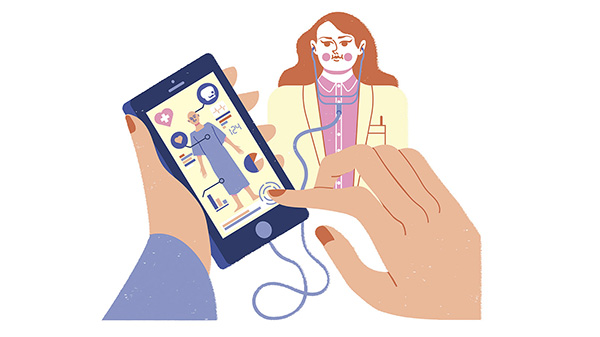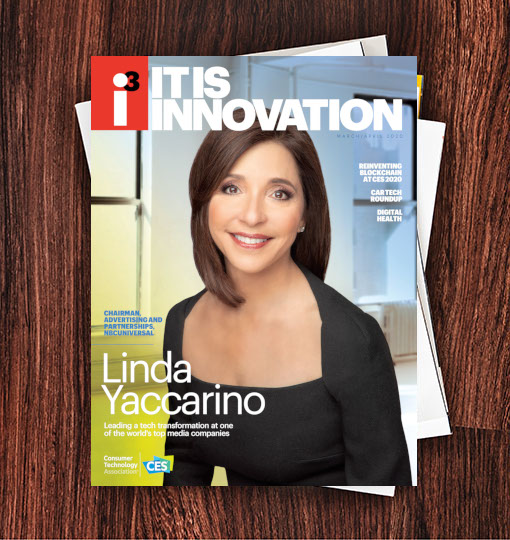To develop its services, Humana has combined technologies for “whole-person health care” as part of the “creation of a better health care ecosystem.” The approach encompasses ''cloud-enabled data democratization, advanced analytics and deep learning.''
Jody Ranck, senior analyst at Chilmark Group, a research firm focused on health information technology, cites the “big differentiators” that are cutting overhead and creating a “wellness ecosystem” that “nudges patients toward better health.” Ranck calls the current avalanche a “health datapalooza,” citing the deluge of information from sensors, and mobile and artificial intelligence(AI) recommendations. He says the focus on “social determinants” of health –demographic factors such as socioeconomic status, education, housing/physical environment and employment –affect individuals’ health and can be evaluated by big data. “
It’s very early with social determinants, but that’s where you have to go,” Ranck explains. “You must make that information useful to doctors and make it actionable.”
These factors are being used to develop new risk profiles that “help health teams determine a plan for individual patients,” Ranck explains, noting this is the rationale for insurance firms and other payers and providers as they seek where to focus their efforts. “Five to 10% of patients account for more than 80% of health care costs,” Ranck says, underscoring the motivation to find ways to identify those high-cost customers and prevent the situations that require expensive treatments. Ranck also sees greater integration between the various levels of the health care value chain.

Humana is one of the large insurers that has plunged into the reinvention of the health care systems. Among its goals is greater coordination between the venues where patients obtain services: primary and specialty providers, “urgent care” clinics, pharmacies as well as at-home care.
“Humana Digital Health and Analytics (DH&A) supports these efforts and meets customers where they are,” explains Marc Willard, vice president of Platform Innovation and Strategic Partnerships at Humana DH&A. The objective is to build “consumer-centric digital products, tools and services that support our integrated care delivery model and enable differentiated health care experiences that are connected, simplified and personalized.”
To develop its services, Humana has combined technologies for “whole-person health care” as part of the “creation of a better health care ecosystem.” The approach encompasses “cloud-enabled data democratization, advanced analytics and deep learning” Willard cites its commitment to creating “a longitudinal health record that delivers a comprehensive view of our members’ health over time.”
One objective is the need to make “the health care system easier to access and navigate.” Humana calls upon a nationwide “array of expertise,” including data scientists, experience designers and engineers. Willard expects Humana to expand its commitment to “virtual care capabilities, which provide convenient and accessible care, slow disease progression and facilitate independence.”
Humana will also continue to build strategic partnerships with organizations and entrepreneurs to test and identify the latest innovations. “These involve experimenting with and learning from new health technology, insight sharing with entrepreneurs in the health ecosystem, and bringing innovative solutions to fruition quickly and efficiently,” he says.
Deloitte's The Future of Health" report concludes that data analysis and technology "will empower consumers to address many routine health issues."
Deloitte’s The Future of Health report expects that technology will drive the restructuring of the health care industry. The consulting firm expects that by 2040, “the consumer will be at the center of the health model” thanks to new interoperable, always-on data tools and “new combinations of services offered by incumbents and new entrants (disruptors).” That is a major overhaul from the current U.S. health care system, which Deloitte describes as “a collection of disconnected components (health plans, hospital systems, pharmaceutical companies and medical device manufacturers).”
Deloitte predicts that integrating wearables and other health monitoring devices into daily activities will accelerate. Its report concludes that data analysis and technology “will empower consumers to address many routine health issues at home,” citing the example of an at-home diagnostic test that could be used to determine whether a visit to a doctor is necessary. The integrated system could also order a prescription if needed which might be delivered by drone to the home.
The report also envisions personal monitors, such as a smart mirror with biosensors that could track body temperature and blood pressure, evaluate skin condition and other factors. It would then mesh that personal information with social determinants such as weather reports to assess whether it is a good day for outdoor exercise. Similarly, a tech-enabled toilet could identify biomarkers that would indicate changes in health status long before symptoms appear, Deloitte contends.
“The next generation of sensors will move us from wearable devices to invisible, always-on sensors that are embedded in the devices that surround us,” Deloitte’s report explains. It cites the availability of data and AI, which will “enable precision well-being and real-time microinterventions that allow us to get ahead of sickness and farahead of catastrophic disease.”
Medical analysts want to use technology to head off chronic illnesses, which account for more than 80% of hospital admissions. Deloitte predicts that, “Greater emphasis on well-being and identifying health risks earlier will result in fewer and less severe diseases, which will reduce health care spending, allowing the reinvestment of this well-being dividend to expand the benefits to the broad population.”
Another study by McKinsey & Company found at many large insurance companies, about half of their IT capital budgets are aimed at technology innovations for both member satisfaction and reduced administrative costs. “Digital leaders recognize the advantages of being a trusted partner for patients,” McKinsey says. “Common areas of focus include guiding patients to the right care” through use of provider-finder tools or timely tailored com¬munications.
McKinsey expects that the next wave of digital innovation in health care will involve machine learning and analytics that “will drive proactive member engagement, anticipate service needs, and solve issues and communication gaps before they even come to a member’s awareness.”
As for the critical issue of who owns personal health data, McKinsey believes that patients “will owntheir clinical data and allow payers and external parties to use it in ways that promote their well-being.”
Reflecting the acceleration of activity in the medical and technology sectors, and managed by CTA’s Health and Fitness Technology Division, the Digital Health Summit at CES 2020 was dubbed “Launching the Decade of Cosmic Transformation.” Among the issues discussed during the two-day program was the growing integration of communications technology and health care. For example, Rod Cruz, general manager of Healthcare Solutions at AT&T Business, focused on the role of 5G technology in speeding up innovation in health care.
Cruz cited “education and training, remote robotic surgery, cognitive behavioral therapy, and medical record management” as major health care sectors where the fifth generation of wireless service will have the biggest impact. He said health care is a low-margin business and is not as innovative as other industries. But he predicts that 5G will stimulate changes in the health care sector.
McKinsey also cites the role of “disruptors” —a new breed of specialized, tech-driven insurance payers. Vator Inc., a service that monitors startup innovators and investors, has identified more than a dozen health care insurance ventures, most less than eight years old and some capitalized at up to $1 billion.
The companies like Bind, Bright Health, Clover, Collective Health and Oscar, have developed services that encourage health monitoring into their insurance coverage. Some are built around Medicare Advantage plans, others focus on self-insured employers, while some promote alternative medicine. For example, Oscar maintains a network of doctors, nurses and coaches so that it can steer members toward its healthy-living advisories and its telemedicine resources. The goal is to minimize doctor appointments and urgent care services. Its pharmacy plan offers prescriptions for as little as $3.
Bright Health is allied with “Local Care” partners, a curated network of doctors, clinics and hospitals for coverage and preventative services. Clover says its emphasis is onanalysis of behavioral and other personal data to customize preventative activities and in-home check-ups.
CTA established a Health and Fitness Technology Division nearly six years ago, as member organizations moved into those businesses and sought ideas “about health care policy and other issues unique to the health care sector,” explains Rene Quashie, CTA’s VP of policy and regulatory affairs, digital health. Division members represent an array of health, technology and communications firms, ranging from AT&T, Best Buy, Google, Hewlett-Packard, Humana and Intel, to Johnson & Johnson, Microsoft, Omron, Philips, Verizon and Walgreens.
Quashie says the member companies want to prepare for “the increased use of technology in health care, especially healthand welless solutions, which have incredible consumer interest.” He cites the growing impact of the aging population, noting that by 2035 for the first time there will be more Americans over age 65 than under 18 years old. “That’s where tech solutions will ameliorate a critical situation,”
Quashie says. Quashie says the consumer-centric health solutions are “clinical grade,” meaning that the devices and apps can “deliver professional care outside the usual channels.” Traditional providers are interested in these solutions because they offer cost containment opportunities as well as quick, efficient service.
Humana’s Willard agrees the avalanche of health technology opportunities has fueled the growing attention to digital health. He summarizes the rationale for most insurance providers as they delve into health technology as the “ability to provide integrated health services, designed to adapt and evolve” as patients’ needs change and as innovative resources become available.

I3, the flagship magazine from the Consumer Technology Association (CTA)®, focuses on innovation in technology, policy and business as well as the entrepreneurs, industry leaders and startups that grow the consumer technology industry. Subscriptions to i3 are available free to qualified participants in the consumer electronics industry.